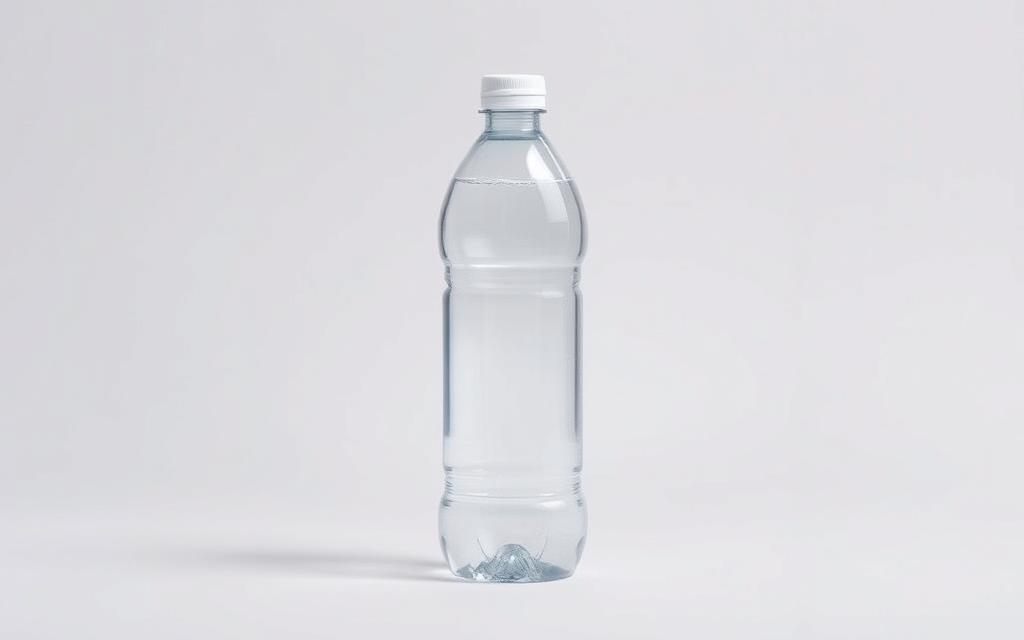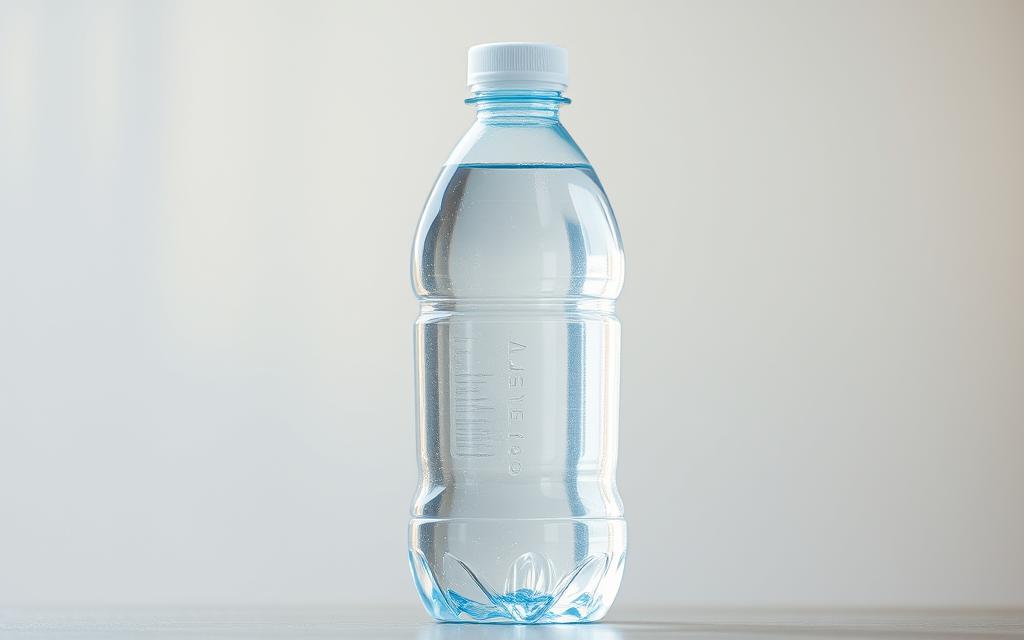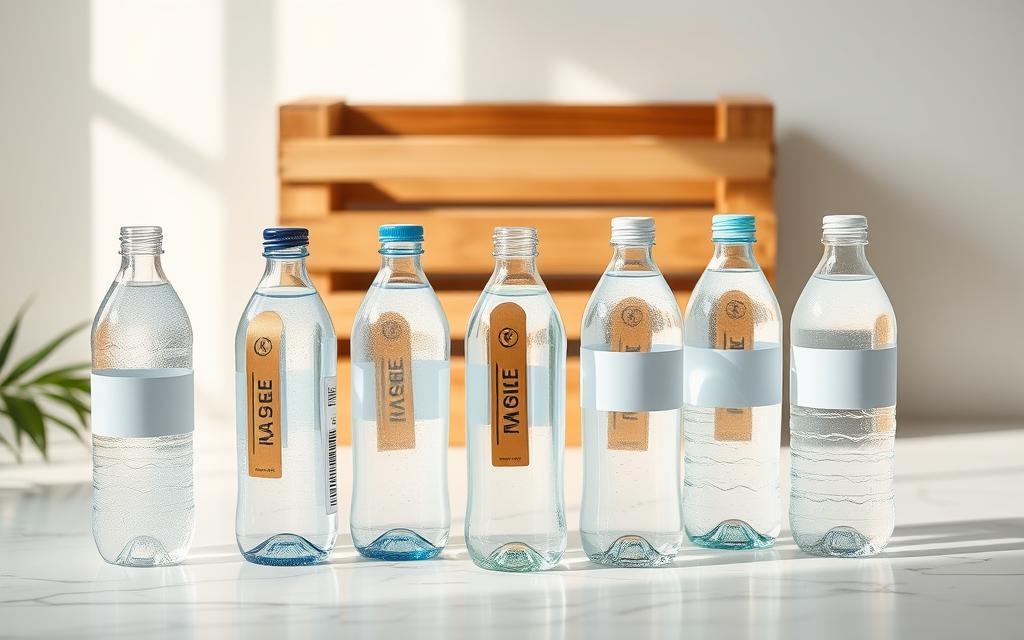Ever thought about what’s in your water bottle? Studies show bottled water has thousands of tiny plastic particles. These could harm our health. I’m looking into safe plastic bottles to find out what we’re really drinking.
Finding the right water bottle is more than just a convenience. It’s about keeping us healthy. With worries about chemicals and health risks, we need to know what makes a bottle safe.
I’ll dive into the world of plastic water bottles. We’ll look at safety standards, materials, and risks. This will help you choose a safe bottle for drinking.
Key Takeaways
- Microscopic plastic particles are present in many water bottles
- Not all plastic bottles are created equal in terms of safety
- Chemical composition plays a critical role in bottle safety
- Choosing the right bottle can minimize health risks
- Consumer awareness is key to making informed hydration choices
Understanding Plastic Safety Standards

Exploring plastic water bottles can be like solving a puzzle. I’ve looked into what makes a BPA-free water bottle safe for daily use. This is important for health and safety.
It’s key to know about plastic safety for non-toxic water bottles. The different types of plastic need us to understand safety standards and rules.
Decoding Plastic Identification Codes
Plastic water bottles have recycling codes that tell us a lot:
- Code 1 (PET): Usually for single-use drinks
- Code 2 (HDPE): Safe for repeated use
- Code 3 (PVC): Avoided because of chemical leaching
- Code 4 (LDPE): Used in squeeze bottles
- Code 5 (PP): Good for reusable containers
- Code 6 (PS): Not good for long-term use
- Code 7 (Other): Mixed plastics with safety issues
FDA Regulatory Landscape
The Food and Drug Administration (FDA) is key in ensuring plastic water bottle safety. They set strict rules for materials touching food and drinks.
| Regulation Aspect | Key Requirements |
|---|---|
| Material Safety | Rigorous testing for chemical migration |
| BPA Restrictions | Banned in baby bottles and sippy cups |
| Migration Limits | Strict standards on chemical transfer |
| Regular Monitoring | Continuous evaluation of plastic safety |
When picking a water bottle, look for BPA-free certifications and check the plastic code. A non-toxic water bottle means more than just avoiding BPA. It’s about overall safety.
Common Types of Plastic Bottles
When picking a recyclable water bottle, it’s key to know the different plastics. This is for your health and the planet. Not all plastics are the same, and understanding each type helps you choose wisely.
I’ve looked into the most common plastics in reusable bottles. This helps you understand the world of water container materials better.
PET: The Most Common Plastic
Polyethylene Terephthalate (PET) is the top plastic for drinks. It’s light, strong, and safe. Plus, it’s easy to recycle.
- Lightweight and durable
- Highly recyclable
- Low risk of chemical leaching
HDPE: The Sturdy Option
High-Density Polyethylene (HDPE) is another favorite for water bottles. It’s strong, safe, and recyclable.
- Stronger and more rigid than PET
- Excellent resistance to chemicals
- Widely accepted in recycling programs
Recyclability of Plastic Materials
Not all plastics can be recycled the same way. Look for bottles with codes 1 (PET) or 2 (HDPE). These are more likely to be recycled locally.
Choosing a bottle that’s recyclable helps the environment. Make sure to check your local recycling rules for proper disposal.
The Risks of Certain Plastics
Looking for the safest plastic water bottle means knowing about chemical risks. Not all plastic bottles are the same. Some can be harmful to our health.
Bisphenol A (BPA) is a big problem in plastic water bottles. It has caused a lot of health worries because of its possible dangers.
Understanding BPA and Its Alternatives
I’ve looked into the healthiest plastic bottles and found BPA can leak harmful stuff into water. Even though there are BPA-free options, some might not be safe.
- BPA may disrupt hormonal systems
- Potential links to reproductive issues
- Possible increased cancer risk
Chemicals to Avoid in Water Bottles
When picking a water bottle, stay away from these harmful chemicals:
- Phthalates
- Polychlorinated biphenyls (PCBs)
- Perfluoroalkyl substances (PFAS)
It’s best to choose bottles made from safer stuff like medical-grade stainless steel or glass. They reduce the risk of chemical exposure.
Awareness is the first step in protecting your health when choosing a water bottle.
Identifying Safe Options
Choosing the right plastic water bottle is important. You need to think about safety, durability, and how it affects the environment. I’ve looked into the top choices to help you pick the best one for staying hydrated every day.
Top Recommended Bottles for Daily Use
Tritan plastic is a top pick for water bottles. It has many benefits:
- BPA-free composition
- Extremely durable design
- Resistant to odors and stains
- Transparent and lightweight
Eco-Friendly Alternatives to Traditional Plastics
There are also eco-friendly water bottle options. Stainless steel and glass bottles are great for those who care about the planet.
| Material | Pros | Cons |
|---|---|---|
| Tritan Plastic | Lightweight, Durable | Less Eco-Friendly |
| Stainless Steel | Highly Sustainable, Long-Lasting | Heavier, More Expensive |
| Glass | 100% Recyclable, No Chemical Leaching | Fragile, Heavier |
When picking an eco-friendly water bottle, think about what you need. Tritan plastic is a good choice for many because it’s safe and practical. The most important thing is to find a bottle that’s good for you and the planet.
Pro tip: Look for bottles with clear recycling codes and third-party safety certifications to ensure you’re making the best choice.
The best plastic water bottle is one that fits your needs and is kind to the environment. Whether you go with Tritan plastic or look at other options, always choose safety and sustainability.
Benefits of Choosing Safe Plastics
Choosing the right safe plastic bottle can change how you drink water every day. It keeps you healthy and helps the planet. Knowing the good things about eco-friendly water bottles helps you make better choices.
Impact on Personal Health
Switching to a safe plastic bottle cuts down on harmful chemicals. Many old water bottles have BPA, which can get into your water. Safe plastic bottles keep you away from these toxins.
- Reduced chemical leaching
- Better hydration quality
- Lower risk of health problems
Environmental Sustainability
Choosing eco-friendly water bottles is good for the planet. They are made to be recycled and use less energy. This helps reduce plastic waste and supports green manufacturing.
| Bottle Type | Environmental Impact | Recyclability |
|---|---|---|
| Traditional Plastic | High Waste Generation | Limited |
| Safe Eco-Friendly Bottle | Minimal Waste | High |
By picking safe plastic bottles, you help your health and the planet. It’s a big step towards a better future.
Choosing wisely today creates a healthier tomorrow for both individuals and our planet.
Brands Known for Safety
Looking for the best plastic water bottle? Knowing which brands focus on safety is key. Not all bottles are the same. Some makers are leaders in creating BPA-free bottles that keep you and the planet safe.
I’ve looked into top brands known for safe and reliable water bottles. Here are some brands that are known for their quality and safety:
- Nalgene: A pioneer in creating durable and safe water bottles
- CamelBak: Known for innovative BPA-free water bottle designs
- YETI: Premium brand with high-performance hydration products
- Contigo: Specializing in leak-proof and safe drinking containers
What Makes a Brand Trustworthy?
When picking the best plastic water bottle brands, look for these signs of safety and reliability:
- FDA-approved materials
- Transparent manufacturing processes
- Third-party safety certifications
- Clear labeling about material composition
Consumer-Focused Safety Features
The top brands offer more than just water. They have features like:
- Advanced filtration systems
- Temperature retention capabilities
- Ergonomic design
- Sustainability commitments
“Your water bottle is more than just a container – it’s a daily health companion.” – Hydration Safety Expert
By choosing brands that focus on safety and innovation, you meet your hydration needs. You get quality and care for the environment.
Tips for Proper Bottle Use
It’s important to take care of your reusable plastic bottle. This keeps it safe and lasts longer. Here are some tips to keep your water bottle clean and working well.
Essential Cleaning Practices
Keeping your bottle clean is key. Here are some cleaning tips:
- Wash your bottle daily with warm, soapy water
- Use a bottle brush to reach all interior surfaces
- Rinse thoroughly to remove all soap residue
- Air dry completely before storing or refilling
Recognizing When to Replace Your Bottle
Even with good care, your bottle will eventually need to be replaced. Look out for these signs:
- Persistent odors that won’t wash away
- Visible scratches or cracks
- Discoloration or cloudiness
- Warping or deformation
Professional tip: You should replace your bottle every 1-2 years. Check it regularly to know when it’s time for a new one.
Your health is worth investing in a clean, safe water bottle!
Balancing Safety with Convenience
Choosing the safest plastic water bottle is more than just picking a safe material. It’s about finding a balance between health and everyday use. I’ve looked into the world of water bottles to guide you in making a smart choice.
Looking for the safest plastic water bottle means considering more than just the material. You’ll find options that are light for carrying but not as durable. Or, you might prefer heavier bottles for their toughness.
Lightweight vs. Durable Choices
Non-toxic water bottles come in different types:
- Ultralight polypropylene (PP) bottles
- Medium-weight HDPE containers
- Heavier stainless steel options
Each type has its own benefits. Light bottles are great for hiking or traveling. But, heavier bottles might be better for the gym or outdoor adventures.
The Challenge of Staying Hydrated
Your perfect water bottle should fit into your daily life easily. It should encourage you to drink more water without risking your health.
| Bottle Type | Weight | Safety Rating | Best Use |
|---|---|---|---|
| PP Plastic | Lightest | Good | Travel, Hiking |
| HDPE Plastic | Light | Very Good | Daily Use |
| Stainless Steel | Heaviest | Excellent | Extreme Conditions |
The safest plastic water bottle is one you’ll use all the time. Think about comfort, how easy it is to clean, and how it fits into your life when choosing.
Conclusion: Making Informed Choices
We’ve looked into water bottle safety and found key insights. Choosing the right plastic bottle is more than a personal choice. It’s about caring for your health and the environment.
It’s important to know about plastic types and their risks. Opting for a recyclable water bottle is more than just easy. It keeps you safe from harmful chemicals and helps the planet. Brands like Nalgene and CamelBak lead in making safe, lasting bottles.
As buyers, we can make smart choices. By picking BPA-free bottles and choosing trusted brands, we lower health risks. The best plastic bottle is one that’s safe and used wisely.
I urge you to use what you’ve learned. Your choice of water bottle is a big step towards better health and the planet. Every choice we make matters for a greener, healthier future.



